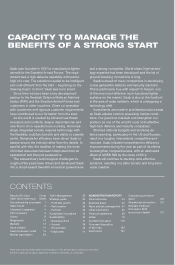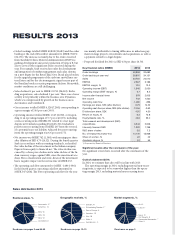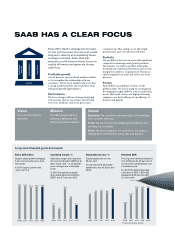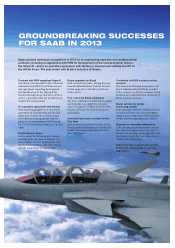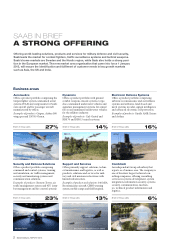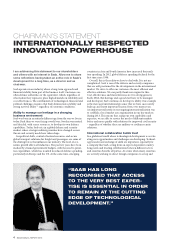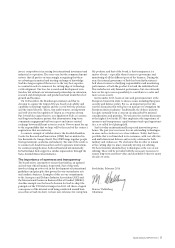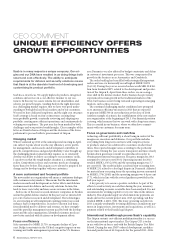Saab 2013 Annual Report Download - page 12
Download and view the complete annual report
Please find page 12 of the 2013 Saab annual report below. You can navigate through the pages in the report by either clicking on the pages listed below, or by using the keyword search tool below to find specific information within the annual report.
8 SAAB ANNUAL REPORT 2013
NEXT GENERATION OF GRIPEN
CUSTOMER CO-OPERATION
FOR SMARTER
MULTIFUNCTIONALITY
The new generation of Gripen is a true multi-
role combat aircraft developed to meet the mar-
ket’s demand for operational functionality. With
avionics at the absolute cutting edge, tactical
customisations can be made more quickly than
ever before.
e agreement with FMV for the order of a new genera-
tion of Gripen was signed in February 2013. It is arguably
one of the largest contracts of all time for Swedish indus-
try. Under the terms of the agreement, another country in
addition to Sweden is required to order the new Gripen.
In August and September both chambers of the Swiss
parliament voted in favour of acquiring Gripen and a
referendum will be held in May 2014. And the Brazilian
government announced in December that it has selected
Gripen as its future ghter aircra .
Production of the new Gripen is done primarily in
Linköping and work is already in full swing. Test ights,
where critical subsystems and their interoperability are
tested to minimise risk, are already well underway. First
delivery is planned for 2018. As previously reported, de-
velopment is proceeding according to plan and contracts
have been signed with all major subcontractors. Negotia-
tions are underway with the Brazilian Air Force for the
purchase of 36 Gripen NGs. Saab’s o er to the Brazilian
government covers technology transfer and industrial
partnership, which may mean that some parts may be
manufactured in Brazil.
More correct from the start
One reason that the development of the Gripen E is pro-
ceeding according to plan is that Saab uses ”model-based
development”. is methodology was secured through
the development of the Neuron unmanned aircra ,
among other things, and is now used in all technical areas
for the Gripen E project. All so ware and hardware de-
velopment is done with the help of computerised models,
meaning that updates are made extremely quickly. Fewer
test ights are needed with this model-based develop-
ment, since many veri cations can be conducted in
simulators rather than in the air. Any problems with the
models are detected at an earlier stage and changes can be
made to the models rather than at a later stage during test
ights. Simply put, things are more correct from the start,
which improves development e ciency.
Co-operation on development
e new Gripen’s solutions need to meet the demands of
the market. A demo programme was therefore initiated
back in 2006 to indicate which new capabilities customers
were demanding of Gripen, such as increased cargo ca-
pacity, new sensors and the ability to stay in the air longer.
In other words, many of the major actions taken for the
Gripen E had already been done in a ying demo version,
so the project’s risks were greatly reduced. Saab showed
with the demo programme that the Gripen E ful ls the
increased requirements while otherwise maintaining per-
formance standards. e Gripen E’s engine will have ap-
proximately 20 per cent greater thrust than engines from
previous Gripen versions. We co-operate closely with
customers to further guarantee that Gripen E’s operation-
al capacity meets customer demands. Saab is responsible
for design, while FMV, the Swedish Armed Forces and the
Swedish Defence Research Agency (FOI) provide ongoing
support and feedback. is is a great strength in ensuring
customer satisfaction when delivery is made.
Countries that have chosen Gripen
Sweden Contract 1983–2006.
Development of Gripen A/B/C/D.
Production of 235 aircraft. Of these,
14 aircraft have been leased to the
Czech Republic.
South Africa Contract
1999. Customisation and
production of 26 Gripen
C/D.
Czech Republic
Contract 2004. Cus-
tomisation of 14 Gripen
C/D that are leased from
Swedish government.
Hungary Contract 2003.
Customisation and produc-
tion of 14 Gripen C/D leased
from Swedish government.
Thailand Contract 2008
– 2010. Customisation and
production of 12 Gripen C/D.
Switzerland Political support in
Parliament in 2013 for purchase of
22 Gripen E.
Brazil Government chooses in 2013
Gripen as its future fi ghter aircraft,
intends to buy 36 Gripen NG.
1990 1995 2000 2005 2010 2015 2020
British Empire Test Pilot
School Contract 2005. Flying
Gripen in Sweden to train future
test pilots.
Sweden Contract 2013. Develop-
ment of Gripen E. Production of 60
aircraft aircraft.


